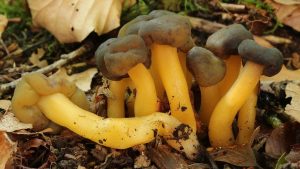#002: Agaricus bisporus
Agaricus bisporus accounts for about 90% of mushroom production in the United States, and 40% worldwide. bisporus is the classic grocery store mushroom. It goes by a variety of common names, including: “button mushroom,” “white mushroom,” “crimini,” and “portabella” (there are a variety of spellings for portabella). That’s right, all of these are actually the same mushroom! Crimini and portabella mushrooms come from a more flavorful brown strain of A. bisporus. Portabellas are exactly the same strain as criminis but the mushrooms have been allowed to mature. A. bisporus is commercially cultivated in large indoor facilities. It is a secondary decomposer, so the substrate it is to be grown on needs to be composted first and then purified of the primary decomposers. The growers then purchase “spawn” to inoculate the substrate with A. bisporus. The spawn consists of A.bisporus mycelium growing on cereal grain. The mycelium will grow through the substrate and eventually produce mushrooms. Once the substrate has been fully colonized a casing layer is added on top of the substrate. The casing layer has two purposes: to keep in moisture and to restrict nutrients to mycelia growing in the casing layer. Both of these encourage the fungus to switch from a vegetative to a reproductive mode of growth. Once the fungus colonizes the casing layer, mushrooms start to fruit. Mushrooms fruit in flushes, where the entire organism fruits simultaneously. These flushes occur every three to five days or so and three to five crops of mushrooms are picked before the crop is replaced with a fresh one. One benefit of producing mushrooms indoors is that the temperature, humidity, and carbon dioxide concentration can be controlled and optimized for each growth phase. I said last week that A. bisporus is not humongous, but could be considered huge. An individual’s size is limited by the size of the tray and amount of substrate. Because the substrate is sterilized before the spawn is added, the mycelium likely has more biomass than a similarly-sized individual in the wild. One of the interesting things about commercial A. bisporus is that most strains are genetically identical. There are two reasons for this. The first is that growers purchase spawn from other companies. The second is that mushrooms are very easy to clone. All you have to do is take a sample from a mushroom (that you purchased from your competitors at the grocery store) and use it to inoculate something to use as spawn.
See Further:
For more than you probably ever wanted to know about Agaricus bisporus and its commercial production, see these sites:
http://botit.botany.wisc.edu/toms_fungi/apr2001.html

![#019: Apiosporina morbosa, Black Knot of Cherry [Archived]](https://www.fungusfactfriday.com/wp-content/themes/hueman/assets/front/img/thumb-medium-empty.png)





![#011: Characteristics of Kingdom Fungi [Archived]](https://www.fungusfactfriday.com/wp-content/themes/hueman/assets/front/img/thumb-small-empty.png)



13 Responses
[…] are the type of mushroom with which we are most familiar. The most common edible mushrooms (white/button/portabella mushrooms, oyster mushrooms, and shiitake mushrooms) are all gilled mushrooms. Amanita muscaria, the most […]
[…] is Agaricus bisporus, which can be found in a number of varieties at your local grocery store (see FFF#002 for more on A. bisporus). The species name birnbaumii pays tribute to a German garden inspector […]
[…] monophyletic group that is usually placed in the family Agaricaceae (along with the gilled mushroom Agaricus bisporus and the puffballs) or in their own family Nidulariaceae. Both of these families are placed in […]
[…] as “white button mushrooms,” “cremini mushrooms,” and “portabella mushrooms” (see FFF#002 for more on A. bisporus). A. bisporus is a very typical Agaricus and is probably the best example […]
[…] are the type of mushroom with which we are most familiar. The most common edible mushrooms (white/button/portabella mushrooms, oyster mushrooms, and shiitake mushrooms), Amanita muscaria – the most recognizable mushroom in […]
[…] In that respect, C. micaceus is like a thinner version of the button mushrooms (Agaricus bisporus, FFF#002) you find at the grocery store. Because they are rather thin-fleshed mushrooms, you need a lot of […]
[…] mushroom” (based on Amanita muscaria), the grocery store button mushroom and other varieties of Agaricus bisporus, shiitakes, oyster mushrooms, and even the major “magic mushrooms” are all basidiomycetes. […]
[…] mushroom” (based on Amanita muscaria), the grocery store button mushroom and other varieties of Agaricus bisporus, shiitakes, oyster mushrooms, and even the major “magic mushrooms” are all basidiomycetes. […]
[…] #002: Agaricus bisporus. (2017, January 20). Retrieved March 19, 2018, from https://www.fungusfactfriday.com/002-agaricus-bisporus/ […]
[…] C. laeve has a boring taxonomic history. It was originally described in 1778 and received its current name in 1936.4 Along with the rest of the bird’s nest genera, C. laeve belongs in the family Agaricaceae.6–9 This means some of its closest relatives are gilled mushrooms in the genus Agaricus, including the button mushroom you find in grocery stores: Agaricus bisporus (FFF#002).10 […]
[…] stipe. Actually, it looks a lot like your typical grocery store mushroom (Agaricus bisporus, FFF#002). The most distinctive feature of L. nuda is its color – all surfaces are tinted purplish when […]
[…] own. This is where the mushroom comes in: an ordinary button mushroom (Agaricus bisporus, FFF#002) provides a perfect surface to keep the cyanobacteria alive. Tiny graphene ribbons in special […]
[…] for aerial hyphae, these proteins are often specifically expressed in mushrooms. Agaricus bisporus (FFF#002), Schizophyllum commune (FFF#085), and Flammulina velutipes (FFF#071) all have specific […]